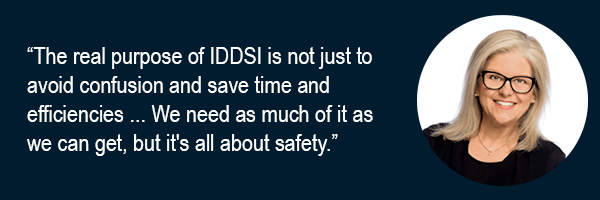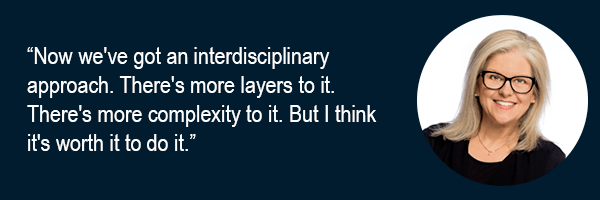Welcome to an informative conversation with Margaret Roche – Registered Dietitian and founder of Roche Dietitians – discussing the "We Test for Safety" training program and how it benefits the International Dysphagia Diet Standardization Initiative (IDDSI), simplifies IDDSI implementation, improves food quality and promotes safety.
Need help getting started with IDDSI? Margaret recently launched an online training program that shows your team everything they need to know about starting with IDDSI. You also get a community of IDDSI professionals to support you through her Roche Dietitians Membership Circle. Discover more on her website.
If you love this episode, listen to Shelly's recent podcast about COVID-19 and how it impacts senior living communities across the country. Want to see more about Boelter's work? Check out our portfolio and some of our service offerings for senior living and healthcare.
Have a topic you'd like us to discuss? Send us your ideas at marketing@boelter.com!
Excerpts
Shelly Sievert: Hello, everyone. I am Shelly Sievert, the Director of Business Development with Boelter Companies. I am excited to be joined today by Maggie Roche from Roche Dietitians. I asked Maggie to be part of the Boelter Wire to talk about dietary standards for people with chewing and swallowing problems. It's a very big issue in senior living, and I'm so excited that Maggie is here with us. Maggie, welcome.
Maggie Roche: Hi, Shelly. Thanks for inviting me. I'm glad to be here.
...
Shelly: We wanted to talk a little bit today about a new standard that is out for diets, for those who have trouble with chewing and swallowing. Can you tell us a little bit about the standards and what does it mean for those in senior living and long-term care?
Maggie: First of all, these new standards have a name, and they're called the International Dysphagia Diet Standardization Initiative. That's a mouth full, and it's shortened to IDDSI, which is the acronym for International Dysphagia Diet Standardization Initiative. IDDSI is a standard for serving texture-modified foods and thickened liquids to those, as you said, with chewing and swallowing problems.
These new standards make sure that anyone serving those with dysphagia have consistent diet terminology. We're all going to use the same names when we talk about these levels or diets for the variety of names that people have with dysphagia. Consistent diet terminology, standardized definitions for each level. So then we will be defining it all the same way as well.
For example, right now some communities serve a chopped diet and some communities serve a diced diet, and they don't define it the same way. Or even, we'll use the term chopped. Some people say, "Well, our chopped diet is a quarter inch," where someone else's chopped diet is a half an inch. Ground and texture-modified foods are sometimes called a ground diet. Sometimes it's called texture-modified foods, but again, if we use the same title, it may be defined differently.
We've got that all worked out. A team of international scientists, a speech pathologist, a dietitian got together and really looked at the literature, and they came to consensus. They looked at best practices and decided what's the best way to standardize this across the board for all ages for different types of needs within the chewing and swallowing world. And then came up with these standards, these international standards.
There's something also I want to add to this, Shelly and that is – there's something really cool that they did – and that is they figured out some simple, reliable testing methods so that any of us who are working with either during food preparation or foodservice or feeding, etc., any of us who are working with these foods have a simple way, by using a spoon and a fork and our observation, to make sure that the foods are at the level that these standards define them to be at. That's an interesting and exciting part about this whole new standardization initiative.
Shelly: Thank you for going through all of that. When we talk about dietary standards, I am not a dietitian. I'm not a nutritionist. I'm not somebody who has even worked in a kitchen at a senior living community or a long-term care community. So I can see why, if you are coming from a different background in foodservice, that a common language helps take care of a lot of these different things that you are mentioning. But, for somebody like me, who is completely green, when it comes to IDDSI and then all of these different terminology, can you just really quickly explain if somebody has dysphagia or has trouble swallowing or trouble chewing, what happens if they are not served food that's appropriate for where they're at with their eating?
Maggie: Oh, that's a good question. Well, someone has dysphagia, they have some type of a deficit in their ability to chew and swallow food. And a lot of it is muscle-related or nerve-related, because think about – I don't know if you know this, but there's several muscles that we have to use to chew and swallow. It takes a lot of coordination. So, if somebody has dysphagia, they have a problem with the ability to coordinate those muscles and chew and swallow.
And the risk is that food goes down the wrong way, and we all know about choking. So, food can block the airway, and people choke. So, we all know about that, but there's also another risk, and that is that small particles of liquid or food or even saliva for that matter can get into the airway in small amounts. But when that gets into the airway, it gets into the lungs. It can cause an infection and people get serious pneumonias, and they can become gravely ill from what we call aspirating, moving in food or liquid into the lungs.
Thank you for explaining that to me. In my career of working in long-term care and in senior living, I remember a story of a gentleman who got his nutrition usually through a feeding tube. And I remember somebody just telling me that she was having a really hard time explaining to his family why they shouldn't be serving him cake because every time after they were there celebrating something with him, he would end up with some kind of pneumonia or something like that. That's exactly what you're talking about. And I know that the people who are serving those who are in a senior living setting or in a long-term care setting, the last thing they want to do is any harm to somebody.
So now bringing it right back around to the new standards, I can see why having that common language is such an important part to take care of these residents.
Maggie: Right, and what happens is we have common language for these several levels, and not only a common language, but they're commonly defined. We all have a standard definition. When these people are being evaluated by a speech pathologist or physician, and they say, okay, this is the type of foods and the consistency of foods and liquids that this person can tolerate. When they create that plan of care and write an order for the level and the types of foods they need, what they have in mind will truly be executed, because we're all talking, singing off the same song sheet, so to speak. We all have the same approach. So that's really important.
We've hit an important point and that is the real purpose of IDDSI is not just to avoid confusion and save time and efficiencies, which it will do in healthcare. We need as much of it as we can get, but it's all about safety. It's all about safety.
 Yeah. And safety is such a huge word. I mean, if we look at like what's happening right now, or what happened this year in 2020 with the pandemic, with COVID-19, safety is such a key piece, and it's not just about hygiene or about cleanliness. There's so many pieces of safety and making sure that these residents have safe food. So they get their nutrition to keep them as healthy as possible, along with preventing things like choking or aspirating or things like that. I can definitely see why safety is such a key part of IDDSI as well.
Yeah. And safety is such a huge word. I mean, if we look at like what's happening right now, or what happened this year in 2020 with the pandemic, with COVID-19, safety is such a key piece, and it's not just about hygiene or about cleanliness. There's so many pieces of safety and making sure that these residents have safe food. So they get their nutrition to keep them as healthy as possible, along with preventing things like choking or aspirating or things like that. I can definitely see why safety is such a key part of IDDSI as well.
Maggie: And you brought up another important point earlier, too, in that the last place we want elders to be right now is in a hospital. Safety keeps them out of the hospital ... Some people have said to me, and I've thought myself, do we need to be talking about IDDSI right now, with everything else that's going on and all the other priorities that we have in terms of our dining services and senior living? But I really do think it's a priority to look at IDDSI because of the testing methods. The testing methods give us away to make sure that what we're serving is appropriate for who we're serving it to. And it reduces risk.
As a matter of fact, I developed a training program and I call it "We Test for Safety." That's the theme. I use that "We Test for Safety" as a theme around the training so the foodservice workers and the caretakers have an understanding of why we're even doing this. Sometimes they're so disconnected from the purpose of what they're doing, especially with therapeutic diets. ... Shelly, you're not alone in terms of somebody who's involved with the industry and may not be as up to date. And, you know, the details of therapeutic diets. That's true of so many of the folks that we work with to help us serve our residents, who walk in the doors, They're coming from other aspects of food and service, and they may not have those details. So it's really important that we train them and they understand what their role is in keeping our folks safe.
Let's go back just a little bit to what you talked about before with the standard levels for the different types of diets. And please correct me if that's not the way that you talk about it. Can you quickly go over, what are the different levels? And then what would the testing for safety look like with that? Just even if it's just very quick bullet points, just to give us an idea of what that means and what we're asking the people in the kitchens at a community to do.
Maggie: There's eight different levels numbered from zero to seven, seven has two levels, let's say within it. I'm going to simplify it by saying it's divided between drinks and foods. Drinks covers thickened liquids.
Remember when I was talking about when people are swallowing, sometimes liquids or foods can get into the airway. Liquids in particular, being slippery, can fall into the airway if they're not well-controlled when we swallow. And so, we thicken liquids to make it easier for them to slowly go through the swallowing process and stay where they need to stay and get into the stomach rather than go into the airway. So there are four levels, five levels for drinks, and it's very simple.
The way we test them is by using a syringe, which is an interesting experiment in physics, but we put 10 millimeters of the thickened liquid in a syringe and open the syringe and let it run for 10 seconds. And the amount of fluid that's left can determine for us how thick that level is. And you can imagine a thinner liquid moves faster. So thinner liquids, the most of it runs out of the syringe. Where, if it's a thicker liquid, it takes longer to get out of the syringe, and by looking at that number on the syringe, it corresponds to the thickness level of the liquid. So that's half of the levels. It's very well explained in the IDDSI standards, which by the way, can be found at IDDSI.org. And there's even a video showing you these syringe tests.
On the food side of things, I'll give you one example, purees, because everybody makes purees. Purees can be tested very simply using a fork and a spoon. We pick up a sample of puree. We hold it up on the fork. If the pureed food is thin, it'll run between the tines of the fork and it will drip. That means, right away, we know that's too thin. If it just has a little tail at the end in between the tines of the fork, it's the perfect consistency. We use observation to make sure that there’s no lumps in it.
Then we use a spoon, and the spoon is introducing some new vocabulary to us when it comes to pureed foods, because we test for stickiness. We take the spoon, we put some food down the spoon, we tilt the spoon. If the food slides off the spoon, that's not sticky. To illustrate it a little deeper for you, imagine that you take a spoonful of peanut butter and you turn a spoonful of peanut butter on the side. That peanut butter is not going anywhere. There are foods like puree pasta that can get really sticky. It will stick to the side of the spoon and we have to manipulate our recipes so that the food is not too sticky. Because as you can imagine, that makes it difficult to swallow if the food is sticky. ... We just spent I don't know how many seconds talking about just a spoon test, but it told us so much about the characteristics of that pureed food.
So, we now have this new language around which we can talk about and evaluate the foods that we serve. And then there's other levels. There's a diced level, and there's a minced and moist level, and there's liquidized food level, etc., all of which have detailed explanation of what the characteristics of that level is and what the testing methods are to verify.
So, this is a lot. Just you talking about the five levels for beverages, with the thickening and all of that, and then the different levels with the foods. And then you talk about even liquefied food, which doesn't fall into a beverage, but it still falls into food. ... You gave a couple of really great resources between your, "We Test for Safety" and then also the IDDSI website.
But I'm imagining that because this hasn’t been out for a while, is this old hat for a lot of communities? Where are you seeing the, um, your client base and or other, um, uh, operators that you've talked to in senior living? How are you finding or what, where are you finding them at? And the level of knowledge of instituting all of these different standards?
Maggie: You know, it's really interesting that you asked that question, because you would think that this is something that since, for example, in the United States, the Academy of Nutrition and Dietetics employ, or I should say adopted it, as our standard of practice and endorses IDDSI, that was May 2019. May 1st, 2019. So it's been a while. It's been at least a year that it has been in effect adopted as a standard.
Now, I've done a lot of trainings since 2018. I have some interesting statistics for you about that. So, I'm so glad you asked me this. In November of 2018, I did a training, a webinar, with over 350 people – dieticians, dietary managers, speech pathologists. ... I asked them one question and gave them five choices to answer it. I asked them, where are you on IDDSI implementation? And their choices were: We're just learning about it; Aware of IDDSI, but no plans yet; Starting implementation; Have started implementation; or well into implementation. In November 2000, 8%, we're just learning about it. People knew about it, but 65% were aware of it, but no plans. 18%, we're just starting implementation. Eight percent, have started implementation, and 1% were well into implementation. And you would expect that because it just came out in 2017. And as you said, there's a lot to think about and there's a lot to do.
Now fast forward exactly one year later. I did another webinar. It just so happened it was exactly a year later, and it was about the same number of people, different people. About 300, 350. And I asked the same questions. The answers went from, just learning about IDDSI from 8% to 10%, aware of IDDSI but no plans yet went from 65% to 38%. So, that means people are moving to the right. They're getting more involved. Starting implementation plans went from 18% to 36%. And then having started went from 8% to 11% and well into implementation went from 1% to 5%.
So, people are moving through this slowly and you know what this indicates to me, not that it's a problem as much as this is a big deal. For example, you know, in the 30 years since I've been a dietitian and planning menus that entire time, this is the biggest change in therapeutic diets I've seen since we went in the 90s from exchange list to carbohydrate counting, and that, by the way, was one diet. This is one therapeutic diet category. But you know, we've already talked about the complexity of the levels. So, it's understandable that people are being thoughtful and taking their time in implementing this. And of course the statistics I just gave you were from last November, almost a year now, but I can't imagine we've seen that much movement on this, you know, in light of the pandemic.
You said this at the beginning and then you just brought it up again. I'm going to touch on this. With the pandemic, that's complicated things for all operators, no matter where in the continuum their residents may be. And we've seen them change, from shutting down dining rooms and closing off activity rooms and everybody staying in their apartments, etc., all these different things that are happening with the pandemic right now. I know you mentioned this at the beginning, but let's go back real quick.
So, all the different service levels, all the different people now who are saying, this is a big deal. We need to start instituting this. We need to be thoughtful about it, all of that. You've got all these different things you've been said, is this something that we need to talk about during the pandemic? And we do, because of the safety piece. Really when it comes down to it, my biggest question is going to be, how can we help simplify all of these things for chefs and dietitians who are working together in community?
Maggie: That's a good question. I thought you were going to say is how can we even ask them? Which is an important question as well. And, of course the answer for that is safety, but they've got other safety concerns, as you pointed out. But, you're right in that, so if we are going to do it – and by the way, it's interesting that people want to do things the right way, and people like to be on the cutting edge, and people like to know the new standards. Because we all want to give superior quality service. We do want our residents safe and we want to be competitive in the marketplace.
Hospitals are adapting because the hospitals have, you know, a 5-day, 10-day cycle menu. They've got a few hundred recipes they have to do, no big deal. We run 5-week cycle menus with two choices and have literally thousands of recipes we have to adapt to this. So that's part of the process. But, to finally answer your question, Shelly, how do we simplify it?
In my mind, this is the way we do it. We start with purees. All of us are serving purees, anyway. All of us already have recipes for purees. And what a better way to empower our teams in terms of giving them a sense of ownership to the therapeutic diets we serve, connecting them to the why people need this. They're already doing it for purees and may not fully understand why they're doing it.
And then two, we're empowering them with this tool, these testing tools, the fork and the spoon. So right away, by implementing IDDSI for purees, what we're doing is we're improving our quality and we're improving our safety at the same time in a process that we're already going through. We're already serving purees and people can get on their page.
That's actually a really good point. If you start with something that they're already doing and then give the background behind it, of why they're doing it, and then give them a greater sense of ownership, I can see that that would maybe be a little bit easier of a step to start implementing these new standards. And I'm just thinking about some of the things that you've already said.
Obviously Boelter is a foodservice equipment company, and we definitely want to work with people on any of their equipment needs, but when it comes down to it, the cost of this isn't like they need to go out and buy all sorts of brand new equipment, spend tens of thousands, if not hundreds of thousands of dollars to be prepared to do this. In many ways, they already have a food processor or a blixer or something like that, that they're already using. Maybe a blender, maybe an immersion blender. They already have that in their kitchen. And then they need a number of forks and spoons. So, cost should not be a deterrent for them to start implementing this.
 I think you said too, that if you go to the IDDSI website, there's even some great videos on there that shows how to do the tests. Am I right? Did you say that?
I think you said too, that if you go to the IDDSI website, there's even some great videos on there that shows how to do the tests. Am I right? Did you say that?
Maggie: Especially the thickened liquid tests. And the other issue, you know, I think the challenge or the hurdle for IDDSI implementation up to this point has not necessarily even been cost. People are willing because they want to provide people high-quality therapeutic diets that are appealing, etc. They want to do it right. Do you know what the bigger hurdle is? It's operational integration.
When we're introducing a new diet level like minced and moist or soft and bite-sized, which are IDDSI levels, you have to change your diet orders, literally the form and everything. You have to contact the physician and change those orders. Everybody has to agree, how are we going to – we have to evaluate people's chewing and swallowing to say, well, this person now is going to go from a texture-modified diet to minced and moist, or from texture-modified to soft and bite-sized.
You've got this complex training that needs to happen at all levels, because people who are serving and maybe caregivers as well as the dining team. Now we've got an interdisciplinary approach. There's more layers to it. There's more complexity to it. I think it's worth it to do it, but maybe now’s not the time.
Maybe if we in dining in our world really nail purees and get them right, which would elevate our service again with quality and safety, gets the attention of our colleagues in other departments, administration. Then from there, the trick is to get a champion to help you implement the other levels, because it does, it will take an interdisciplinary approach.
The beautiful thing about starting with purees is you can work independently in dining to get your purees tested appropriately ... and to get your team trained, their toes in the water on IDDSI, the IDDSI concepts, the language. For example, IDDSI pureed level is known as level four. And it has an abbreviation of PU4 and start using that and integrating that through your puree processes that you already doing. It just helps set the tone. It's a layer, it's a base layer of IDDSI that is accessible to everybody right now. That effort is worth the outcome of improved quality and safety.
 Let me just reiterate that, because I think that what you just went over is really important. So, we know when we look at all of IDDSI, we know that to institute the standard across the board with all of the service levels, it's quite a bit of work because it does require that multi- or interdisciplinary team. You have to have a lot of evaluation on all of the different types of diets. You have to write your diet records differently, etc.
Let me just reiterate that, because I think that what you just went over is really important. So, we know when we look at all of IDDSI, we know that to institute the standard across the board with all of the service levels, it's quite a bit of work because it does require that multi- or interdisciplinary team. You have to have a lot of evaluation on all of the different types of diets. You have to write your diet records differently, etc.
So, one of the easiest ways to start instituting this is to really start in the kitchen or with dietary to make sure that they are using some of the common languages for their purees. Since they're already doing the puree, they can look at the different languages, start labeling that way, really own the pureed diets. Really make sure that there are people who are getting them. They're nailed, they're happy with their purees, etc. And then that can create that interest into the other departments where they can say, wow, you guys are doing a really great job. Let's do more. And then we can get a champion to help roll it out to the other teams, etc. Is that what you're saying?
Maggie: That’s exactly what I'm saying. And it's not theoretical. I mean, I came up with this because that's what I've had to do with my clients. Because it's baby steps. It helps them digest it. And the other thing that people keep saying to me is I gotta train all these folks, you know? I get it. It takes us awhile to get it at our level. People in management, dietitians, etc., we get it now and we embrace it and we understand the importance of it, but now I got to get my whole team on board. And not only my team, but you know, the other members in our communities that are dealing with food activities, caretakers, etc. This evolved out of necessity, and it's working. it's really helping people feel confident with it.
What you just said, I think is so important, that it's not that this is theoretical. You've actually done this, and it's working. And I think that that's so encouraging for anybody else in that like 38% that says they're aware of IDDSI, but they haven't started implementing it yet, that they see, oh, wait a second, this doesn't have to be an ultra-complicated thing to start off with.
And I think that sometimes when we look at these new standards, as a whole, anybody can look at it and be really overwhelmed and say, oh, it's not worth it. It's not going to work, etc. Instead of saying, wait a second, let's take the steps that make sense the first time. And by the way, it is working because you have proof with your current clients.
Maggie: It's funny, I got an email from a dietitian. ... There is even a hurdle for us at the dietitian level where we're so gung-ho on these therapeutic diets. And she responded, I asked the question, what do you think? What are you thinking about IDDSI? and she responded back to me. And she said, when I heard about IDDSI, I was in quiet despair.
I laughed out loud when I heard that, because I thought it's a very dramatic thing to say. And I know she was kind of joking, but only kind of, because we do think, okay, this is great. I want to do this. But then when you dig into it, you're like, oh my gosh, this is a lot. And so, I knew I had to do it because I'm in the business of therapeutic diets.
So, I dove in, and I know the kind of the spirit of it. It's just such a good phrase, that you can have when you think about it, think about actually implementing it. And that's why I came up with these strategies and these training program and all of this, these webinars that I do. I have done webinars on IDDSI and have 2000 people sign up because people care and they're interested in the topic and need to know more. They're really interested in knowing more about the IDDSI implementation.
So, I thought it was really important to take a step back and say, alright, look, we don't have to be perfectionist here. We don't have to bite off a big chunk of this thing. Let's start with what we know, which is true on all new endeavors, right? Start where you know, learn as you go and build brick by brick. And one of the things I like to say at our offices where we're doing these types of projects is, Rome wasn't built in a day, but they laid brick every hour, you know? So let's just keep going. Let's just keep going.
I have to ask, have you heard back from that client? Is she no longer in quiet despair?
Maggie: She's okay. She's okay. It was a dietician colleague, rather than a client and I brought her in off the ledge, so she's okay now.
Oh, thank goodness. Thank goodness. Quiet despair. That sounds a little lonely.
Maggie: There was a truth it. That's why sometimes those jokes are so funny.
Anytime somebody can dramatically say where they're at, that always gets me too.
Well, Maggie, you have been so great to talk with today about the IDDSI standards, about the reason behind putting these into place, especially when it comes down to it, that safety piece. And then on top of that, that high quality of care that I know that every single person who is in senior living wants to offer their vulnerable residents. And I think it's just so important.
So, with that, you've answered pretty much all my questions. Do you have any last thoughts that you would like to share today?
Maggie: Yes. I am a little bit of an IDDSI geek, so I love talking to people in their journey for IDDSI. I encourage everyone to reach out to me, and best way to do it... I'm really digging these days because we cannot connect physical with people. I've really had some great conversations and connections with people on LinkedIn. So, check me out on LinkedIn at Margaret Roche, and you'll find me, my pictures there. It's Margaret Roche, Roach Dieticians, and you'll find me there.
Also, I encourage everybody to check out our website, rochedietitians.com ... We have on there tons of info on IDDSI. We have what we call our ultimate guide to IDDSI. We've got, we're just getting a lot of traffic there. We also have a really cool blog post on there that I think we had over 5,000 people look at it because it talks about the role of the dietitian-chef partnership in IDDSI. We interviewed folks from around the world and how they've approached IDDSI, particularly with pureed foods. We’ve got some cool pictures of pureed foods on that blog post. So, lots of stuff on the website, but I'm always happy to reach out and connect with people personally as well. Because, like I said, it’s one of my favorite topics
Well, I appreciate your time today and the passion that you bring to this. I'm sure that anybody listening would love to connect with you. And make sure that you check her out on LinkedIn. ... Maggie, I really do appreciate your time today. Hopefully the next time we talk, we'll find out that your survey is seeing far more people who have instituted IDDSI as part of their standards.
Maggie: Thank you, Shelly. And I also want to say thank you to Boelter because you’ve been early champions of IDDSI. I know that we've used your space in the past to host workshops and hands-on workshops. I really appreciate all the support that we as a community have gotten from Boelter in terms of getting IDDSI going and supporting those we care for.

The Boelter Wire is an episodic podcast that focuses on thought-leadership conversations with industry experts and established partners, and is designed to help listeners evolve their business, stay competitive and pursue their passions.
Subscribe to The Boelter Wire here or on Spotify, Google Play, Apple Podcasts or Amazon Music.
.jpg?width=192&name=BLT_Only_Logo_Black%20(19).jpg)


